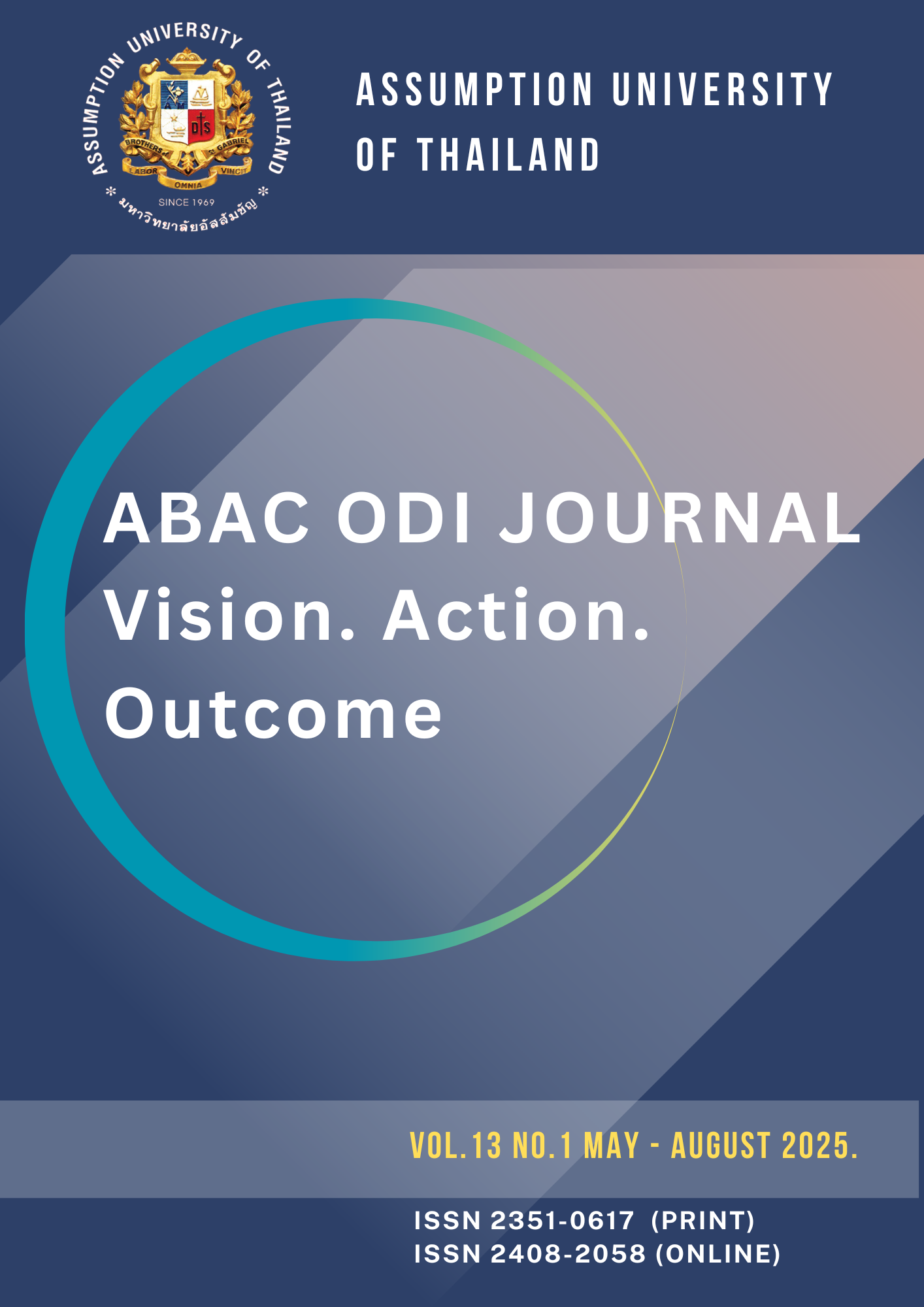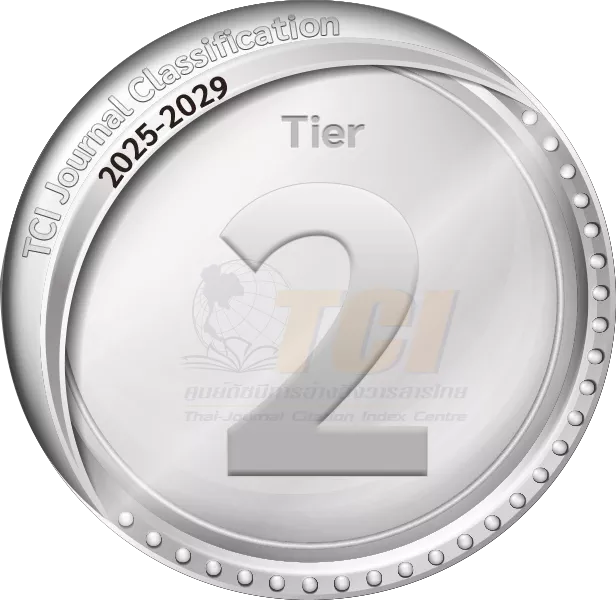The Role of TikTok in Shaping Wan Music Trends in Thailand: A Digital Ethnography during the COVID-19 Pandemic
DOI:
https://doi.org/10.14456/abacodijournal.2025.35Keywords:
TikTok, Wan Music in Thailand, User-Generated Content (UGC), Digital Ethnography, Thai music industryAbstract
The advent of digital technology has changed music consumption patterns, driving trends. The emergence of platforms such as TikTok as major influencers in contemporary music composition trends. Due to the disturbing impact of the COVID-19 pandemic on traditional income streams within the music industry. Online platforms like TikTok have gained a new reputation in the music industry as a ways to promote and participate in music. This paper is an in-depth analysis examination of TikTok's role as a form of User Generated Content (UGC) and its consequent impact on the Thai music industry, with a specific focus on the genre known as "Wan music." Qualitative research methods, including participatory observation and data analysis, the The study sheds light on the ways in which TikTok users, predominantly females, interact with and propagate Wan songs, thus enhancing the vibrant community around this musical genre. Through an extensive literature review including original fieldwork, seminal works in the fields of digital ethnography, social media research, and music marketing. This paper empirical findings in a broader theoretical framework. By integrating existing scholarship studies shed light on topics such as digital ethnography, UGC, and music marketing on the nuanced dynamics at play within the intersection of TikTok, Thai music, and the COVID-19 pandemic. The findings underscore the transformative influence of TikTok as a catalyst for music discovery, dissemination, and audience engagement, particularly within the unique socio-cultural milieu of Thailand during a period of global upheaval. Ultimately, this paper contributes to a deeper understanding of the multifaceted role played by digital platforms in reshaping contemporary music ecosystems, offering insights that are pertinent not only to scholars and practitioners in the fields of media studies and musicology but also to stakeholders within the broader creative industries landscape.
References
Aguimbag, M. (2024). How TikTok Influences Music Discovery and Streaming. https://www.blog.musiccareers.co/how-tiktok-influences-music-discovery-and-streaming/?utm_source=chatgpt.com
Bahtar, A. C., & Muda, M. (2016). The impact of User – Generated Content (UGC) on product reviews towards online purchasing – A conceptual framework. Procedia Economics and Finance 37, 337-342
Driscoll, L., Brizee, A., Salvo, M., & Sousa, A. (2008). User-Centered Theory. International Journal of Information Systems and Social Change, 1(4), 53-67.
Halliday, S. V. (2016). User-Generated Content about Brands: Understanding its Creators and Consumers. Journal of Business Research, 69(1), 137-144.
Harn, A. (2022). How TikTok’s algorithm made it a success: ‘It pushes the boundaries.’ https://www.theguardian.com/technology/2022/oct/23/tiktok-rise-algorithm-popularity.
Hennig-Thurau, T., Gwinner, K. P., Walsh, G., & Gremler, D. D. (2004). Electronic Word- of-Mouth via Consumer-Opinion Platforms: What motivates consumers to articulate themselves on the Internet?. Journal of Interactive Marketing, 18, 38-52
Jaffar, B. A., Riaz, S., & Mushtaq, A. (2019). Living in a moment: Impact of TikTok on influencing the younger generation into micro-fame. Journal of Content, Community & Communication, 10, 187-194.
Kriangwattana, P. (2007). Dek Wan: From social problems to good citizenship.
http://elibrary.constitutionalcourt.or.th/document/read.php?bibid=11819&cat =4&typ=4&file=IS6D_610626.pdf
Lukan, T. (2023). A Journey from Researcher to Influencer: TikTok as a methodological Tool. https://elephantinthelab.org/a-journey-from-researcher-to-influencer-tiktok-as-a-methodological-tool/?utm_source=chatgpt.com
Manap, N. A. A., & Adzharudin, N. (2013). Understanding the Impact of Electronic Word-of- Mouth (EWOM) on Generation Y's Purchasing Decision: A Case Study of Public Universities in Klang Valley, Malaysia. International Journal of Economics, Commerce and Management, 1(6), 1-12.
Miles, K. (2024). 8 Best Types of User-Generated Content.
https://taggbox.com/blog/types-of-user-generated-content/
Naeem, M., & Okafor, S. (2019). User-Generated Content and Consumer Brand Engagement. Leveraging Computer-Mediated Marketing Environments.
Newsroom.tiktok.com. (2023). Music Impact Report Confirms: TikTok Fuels Music Discovery. https://newsroom.tiktok.com/en-us/music-impact-report-confirms-tiktok-fuels-music-discovery?utm_source=chatgpt.com
Nyein, K. N. (2019). The Impact of the User Generated Content on Purchase Intention Among Facebook & Instagram Users: Case Study of Food & Beverage Industry in Yangon, Myanmar. Independent Study, Bangkok University.
Prakai, N. (2020). TikTok Users in Thailand: A Demographic Study. Journal of Social Media Studies, 12(2), 89-104.
Putnark, V. (2018). Anyone can be a director and an actor: The identity of Thai teenagers in the Tik Tok app.
https://thematter.co/social/tik-tok-and-youth- spectacle-identity/51692
Sanook.com. (2015). The Rise of "Wan Music": A Cultural Phenomenon in Thailand.
https://www.sanook.com/music/2367757/
Schellewald, A. (2021). Communicative Forms on TikTok: Perspective from Digital Ethnography. International Journal of Communication, 15(2021), 1437-1457.
Stone, J. (2020). The State of the music industry in 2020.
https://www.toptal.com/finance/market-research-analysts/state-of-music-industry
Thai, H. (2021). Insights on the TikTok Algorithm (Deep Dive Inside The AI Machine). https://www.signalytics.ai/tiktok-algorithm/.
Xu, L., Yan, X., & Zhang, Z. (2019). Research on the causes of the “TikTok” app becoming popular and the existing problems. Journal of Advanced Management Science, 7, 59-63.
Zhi, J. (2018). TikTok app opens the second half of the National Entertainment Era Short Video Commercial Realization Test. Future Commercial Press, 18(3), 55-65.
Zhi, L. (2018). Exploring the Distinctive Features of TikTok: A Comparative Analysis. Journal of Social Media Trends, 5(3), 112-126.




